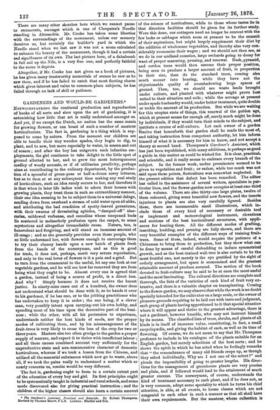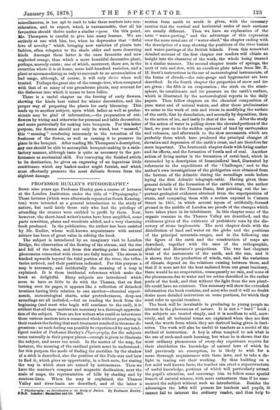GARDENERS AND WOULD-BE GARDENERS.* liarwrrasT&NDD:G the continual production and reproduction
.43f books of all sorts and sizes upon the art of gardening, it is astonishing how little that art is really understood amongst us.
And yet, if we except the Dutch, no nation has the same mania for growing flowers, or can boast of such a number of amateur
horticulturists. The fact is, gardening is a thing which is sup- posed to come by nature. From the moment our children are able to handle their tiny wooden spades, they begin to dig, to plant, and to sow, but more especially to water, in season and out of season ; and after the boy has outgrown such infantine em- ployments, the girl continues to take delight in the little spot of ground allotted to her, and to grow the most heterogeneous medley of weedy annuals, or if of utilitarian proclivity, perhaps aims at contributing to the culinary department, by the produc- tion of a spoonful of green-peas or half-a-dozen sorry lettuces, but as to then or at any subsequent time making any real study of horticulture, such an idea rarely occurs to her, and therefore it is that when in later life ladies wish to adorn their houses with growing plants, they treat them in such an extraordinary manner, their one idea seeming to be to subject them to a universal deluge, sending down from overhead a stream of cold water upon all alike, and attributing the bad condition of spotty-leaved geraniums, with their swarms of devastating aphides, "damped-off" eine- rarias, mildewed verbenas, and camellias whose unopened buds lie scattered in melancholy profusion upon the carpet, to some mysterious and altogether irremediable cause. Nature, too, is benevolent and forgiving, and will stand an immense amount of ill-usage; and so she generally provides even these people, who so little understand her, with flowers enough to encourage them to try their clumsy hands upon a new batch of plants fresh from the hands of the nurseryman, and as this is good for trade, it does not, perhaps, merit very severe reprobation, and only to the real lover of flowers is it a pain and a grief. But to turn from the ornamental to the useful, let any one look at our vegetable gardens, and he will see how far removed they are from being what they ought to be. Almost every one is agreed that a garden, instead of being a source of profit, is a direct loss. And why ? Simply because it does not receive the barest justice. In ninety-nine cases out of a hundred, the owner does not understand what should be done with it, so be hands it over to his gardener, if he has one, or to the jobbing practitioner who has undertaken to keep it in order ; the one being, if a clever man, very possibly intent upon carrying-out his own hobby, and spending most of his time upon the decorative part of the busi- ness; while the other, with all his pretension to experience, understands neither the best kinds of seeds, nor the proper modes of cultivating them, and by his mismanagement of the fruit-trees is very likely to cause the loss of the crop for two or three years. Masters also too often grudge to the garden a proper supply of manure, and expect it to thrive with insufficient labour ; and all these causes combined account very sufficiently for the unproductive state and non-remunerative character of domestic horticulture, whereas if we took a lesson from the Chinese, and utilised all the manurial substances which now go to waste, above all, if we took the pains really to understand a matter which so nearly concenis us, results would be very different.
The fact is, gardening ought to form to a certain extent part of the education of every boy and girl. Its first principles ought to be systematically taught in industrial and rural schools, and some mode discovered also for giving practical instruction ; and the children of the higher classes should also learn a certain amount
• 771e Gardener's Assistant, Practical and Scientific. By Robert Thompson. Revised by Thomas Moore, F.L.S. London : Mackie and Son. of the science of horticulture, while to those whose tastes lie in that direction facilities should be given for its further study. Were this done, our cottagers need no longer be content with the few leeks or cabbages which seem at present to be the summit of their aspirations, but might largely supplement their diet by the addition of wholesome vegetables, and thereby also very con- siderably economise their wages ; and we should not then see, as we do in our midland counties, large orchards going to decay for want of proper manuring, pruning, and renewal. Bush, pyramid, and cordon trees would then assume their proper position, being seen to produce a larger amount of fruit, in proportion to their size, than do the standard trees, coming also much sooner into bearing, while they have not the objectionable quality of overshadowing large spaces of ground. Then, too, we should see waste lands brought under culture, and planted with whatever might prove best suited to their situation and soils ; while the acreage at present under spade husbandry would, under better treatment, quite double or treble the amount of its production. But while we are waiting for this utopian state of things, this renewal of the golden age, which at present seems far enough off, surely much might be done by individuals, if they would turn their minds to the subject, and institute a course of self-culture. Let each owner of a garden fisolve that henceforth that garden shall be made the most of and taking instruction from competent authority, let him inform himself of what it is necessary for him to know, and not accept a theory at second hand. Thompson's Gardener's Assistant, which has just been republished, with many additions, is perhaps as good a guide in this matter as could be wished for. It is clear, practical, and scientific, and it really seems to embrace every branch of the subject. In the former work, undue prominence seemed to be given to vegetables and fruit ; or rather, while too much WAS not said upon these points, floriculture was somewhat neglected. In the present edition that defect has been remedied. The editor has called in the assistance of several writers, specialists in par- ticular lines, and the flower-garden now occupies at least one-third of the volume. There are also thirty-one large plates, twelve of them coloured, giving some beautiful new flowers, and the insects injurious to plants are also very carefully figured. Besides these, there are innumerable small illustrations, which in- clude those of every kind of necessary or desirable tool or implement and meteorological instrument, elevations and sections of the best horticultural structures, with appli- ances for heating them. All the different modes of grafting, marching, budding, and pruning are fully shown, and there are very beautiful examples of the different ways of training fruit- trees. Some of these, indeed, would require the patience of a Chinaman to bring them to perfection, but they show what can be done by means of careful disbudding to induce symmetrical growth, and as the best-trained wall-tree is also certain to be the most fruitful one, not merely is the eye gratified by the sight of orderly arrangement, but space is economised and the greatest attainable amount of produce secured. The section of the book devoted to fruit-culture may be said to be at once the most useful and the most fascinating. The cultural directions are complete and thorough, the lists of the varieties of each kind of fruit very ex- tensive, and there is a valuable chapter on transplanting. Coming to the flower-garden, we may observe that while the work is no doubt specially intended for the cultivator on a large scale, or the owner of pleasure-grounds requiring to be laid out with taste and judgment, each group of plants having apportioned to it that special situation where it will appear and thrive to the greatest advantage, there is not a gardener, however bumble, who may not instruct himself by its means. The classified lists of trees, shrubs, and plants of all kinds is in itself of immense value, constituting, in fact, a small encyclopmdia, and giving the habitat of each, as well as its time of flowering. Of course, we do not mean to say that Mr. Thompson professes to include in his catalogue all the plants suitable for an English garden, but merely selections of the best sorts ; and he shows the spirit in which he has acted when he feelingly remarks that "the remembrance of many old friends crops up, as though they asked individually, Why am I not one of the select ?" and pleads the impossibility of going to greater lengths. His direc- tions for the management of greenhouse plants are very precise and plain, and if followed would lead to the attainment of much greater success. The nurseryman, of course, understands the kind of treatment necessary to each plant, and if he does not, as is very common, adopt some speciality to which he turns his chief attention, is able, at all events, to house classes which are not congenial to each other in such a manner as that all shall have their own requirements. But the amateur, whose collection is
miscellaneous, is too apt to omit to take these matters into con- sideration, and to expect, which is unreasonable, that all his favourites should thrive under a similar regeme. On this point, Mr. Thompson is careful to give him many lessons. We are entirely at one with him, too, when he deprecates that "fitful love of novelty" which, bringing new varieties of plants into fashion, often relegates to the shade older and more deserving kinds. Amongst these latter is the once favourite and now neglected orange, than which a more beautiful decorative plant, perhaps, scarcely exists ; one of which, moreover, there are, in the countries where it is at home, some half-hundred varieties, and a plant so accommodating as only to succumb to an accumulation of bad usage, although, of course, it will only thrive when well treated. Perhaps the great size of the orange-tree, when compared with that of so many of our greenhouse plants, may account for the disfavour into which it seems to have fallen.
There is a useful chapter on the forcing of early flowers, showing the kinds best suited for winter decoration, and the proper way of preparing the plants for early blooming. This leads up to another subject, upon which ladies as well as profes- sionals may be glad of information,—the preparation of cut- flowers by wiring and otherwise for personal and table decoration, and more particularly for making into bouquets. For this latter purpose, the flowers should not only be wired, but "messed," this " messing " conducing immensely to the retention of the freshness of the flower, as well as causing it to preserve its place in the bouquet. After reading Mr. Thompson's description, Any one should be able to accomplish bouquet-making in a satis- factory manner, although taste is quite as necessary to the per- formance as mechanical skill. For conveying the finished article to its destination, he gives an engraving of an ingenious little contrivance which any basket-maker might furnish, and which must effectually preserve the most delicate flowers from the slightest damage.



































 Previous page
Previous page